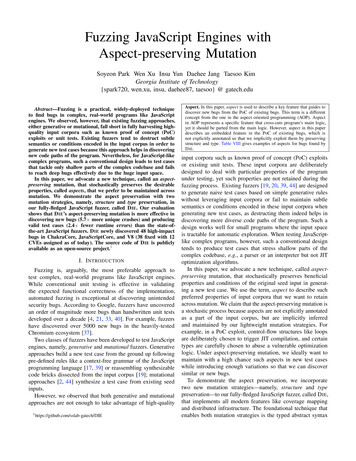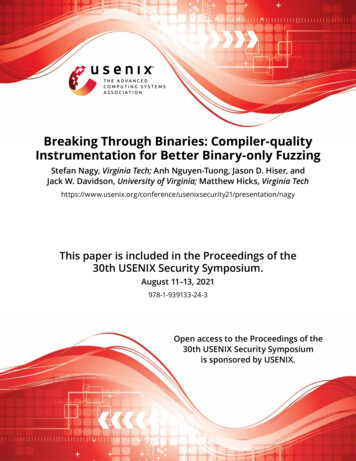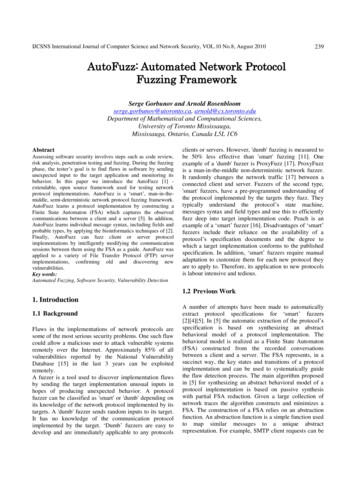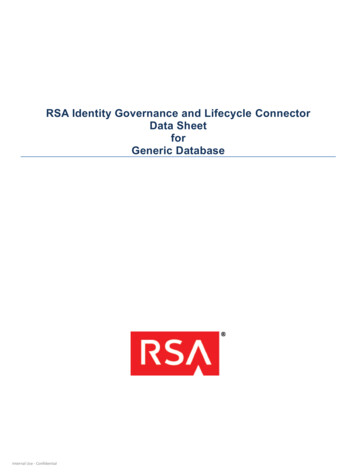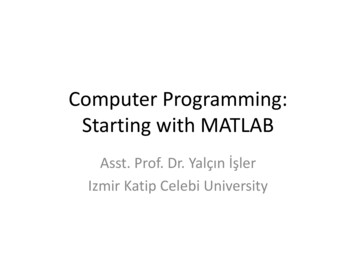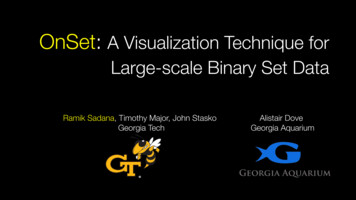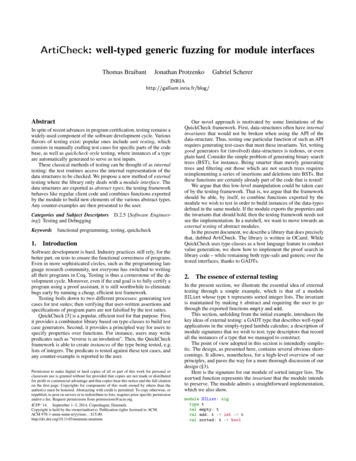
Transcription
ArtiCheck: well-typed generic fuzzing for module interfacesThomas BraibantJonathan ProtzenkoGabriel n spite of recent advances in program certification, testing remains awidely-used component of the software development cycle. Variousflavors of testing exist: popular ones include unit testing, whichconsists in manually crafting test cases for specific parts of the codebase, as well as quickcheck-style testing, where instances of a typeare automatically generated to serve as test inputs.These classical methods of testing can be thought of as internaltesting: the test routines access the internal representation of thedata structures to be checked. We propose a new method of externaltesting where the library only deals with a module interface. Thedata structures are exported as abstract types; the testing frameworkbehaves like regular client code and combines functions exportedby the module to build new elements of the various abstract types.Any counter-examples are then presented to the user.Categories and Subject Descriptors D.2.5 [Software Engineering]: Testing and DebuggingKeywords functional programming, testing, quickcheck1.IntroductionSoftware development is hard. Industry practices still rely, for thebetter part, on tests to ensure the functional correctness of programs.Even in more sophisticated circles, such as the programming language research community, not everyone has switched to writingall their programs in Coq. Testing is thus a cornerstone of the development cycle. Moreover, even if the end goal is to fully certify aprogram using a proof assistant, it is still worthwhile to eliminatebugs early by running a cheap, efficient test framework.Testing boils down to two different processes: generating testcases for test suites; then verifying that user-written assertions andspecifications of program parts are not falsified by the test suites.QuickCheck [5] is a popular, efficient tool for that purpose. First,it provides a combinator library based on type-classes to build testcase generators. Second, it provides a principled way for users tospecify properties over functions. For instance, users may writepredicates such as “reverse is an involution”. Then, the QuickCheckframework is able to create instances of the type being tested, e.g.lists of integers. The predicate is tested against these test cases, andany counter-example is reported to the user.Permission to make digital or hard copies of all or part of this work for personal orclassroom use is granted without fee provided that copies are not made or distributedfor profit or commercial advantage and that copies bear this notice and the full citationon the first page. Copyrights for components of this work owned by others than theauthor(s) must be honored. Abstracting with credit is permitted. To copy otherwise, orrepublish, to post on servers or to redistribute to lists, requires prior specific permissionand/or a fee. Request permissions from permissions@acm.org.ICFP ’14, September 1–3, 2014, Copenhagen, Denmark.Copyright is held by the owner/author(s). Publication rights licensed to ACM.ACM 978-1-nnnn-nnnn-n/yy/mm. . . 15.00.http://dx.doi.org/10.1145/nnnnnnn.nnnnnnnOur novel approach is motivated by some limitations of theQuickCheck framework. First, data-structures often have internalinvariants that would not be broken when using the API of thedata-structure. Thus, testing one particular function of such an APIrequires generating test-cases that meet these invariants. Yet, writinggood generators for (involved) data-structures is tedious, or evenplain hard. Consider the simple problem of generating binary searchtrees (BST), for instance. Being smarter than merely generatingtrees and filtering out those which are not search trees requiresreimplementing a series of insertions and deletions into BSTs. Butthese functions are certainly already part of the code that is tested!We argue that this low-level manipulation could be taken careof by the testing framework. That is, we argue that the frameworkshould be able, by itself, to combine functions exported by themodule we wish to test in order to build instances of the data-typesdefined in the same module. If the module exports the properties andthe invariants that should hold, then the testing framework needs notsee the implementation. In a nutshell, we want to move towards anexternal testing of abstract modules.In the present document, we describe a library that does preciselythat, dubbed ArtiCheck. The library is written in OCaml. WhileQuickCheck uses type-classes as a host language feature to conductvalue generation, we show how to implement the proof search inlibrary code – while remaining both type-safe and generic over thetested interfaces, thanks to GADTs.2.The essence of external testingIn the present section, we illustrate the essential idea of externaltesting through a simple example, which is that of a moduleSIList whose type t represents sorted integer lists. The invariantis maintained by making t abstract and requiring the user to gothrough the exported functions empty and add.This section, unfolding from the initial example, introduces thekey ideas of external testing: a GADT type that describes well-typedapplications in the simply-typed lambda calculus; a description ofmodule signatures that we wish to test; type descriptors that recordall the instances of a type that we managed to construct.The point of view adopted in this section is intendedly simplistic. The design, as presented here, contains several obvious shortcomings. It allows, nonetheless, for a high-level overview of ourprinciples, and paves the way for a more thorough discussion of ourdesign (§3).Here is the signature for our module of sorted integer lists. Thesorted function represents the invariant that the module intendsto preserve. The module admits a straightforward implementation,which we also show.module SIList: sigtype tval empty: tval add: t - int - tval sorted: t - bool
end structtype t int listlet empty []let rec add x function [] - [x] t::q - if t x then t::add x q else x::t::qlet rec sorted function [] [ ] - true t1::(t2:: as q) - t1 t2 && sorted qendRoughly speaking, our goal is to generate, as if we were client codeof the module, instances of type t using only the functions exportedby the module. Therefore, one of our first requirements is a datastructure for keeping track of the t’s created so far. We also need tokeep track of the integers we have generated so far, since they arenecessary to call the add function: ArtiCheck will thus manipulateseveral ty’s for all the types it handles.type ’a ty { (* Other implementation details omitted *)mutable enum: ’a list;fresh: (’a list - ’a) option; }A type descriptor ’a ty keeps track of all the instances of ’a wehave created so far in its enum field. Built-in types such as int donot belong to the set of types whose invariants we wish to check. Forsuch types, we provide a fresh function that generates an instancedifferent from all that we have generated so far.From the point of view of the client code, all we can do iscombine add and empty to generate new instances. ArtiCheck, as afake client, should thus behave similarly and automatically performrepeated applications of add so as to generate new instances. Wethus need a description of what combinations of functions are legalfor ArtiCheck to perform.In essence, we want to represent well-typed applications in thesimply-typed lambda-calculus. This can be embedded in OCamlusing generalized algebraic data types (GADTs). We define theGADT (’a, ’b) fn, which describes ways to generate instancesof type ’b using a function of type ’a. We call it a functiondescriptor.type ( , ) fn Ret: ’a ty - (’a,’a) fn Fun: ’a ty * (’b, ’c) fn - (’a - ’b, ’c) fn(* Helpers for creating [fn]’s. *)let (@- ) ty fd Fun (ty,fd)let returning ty Ret tyThe Ret case describes a constant value, which has type ’a andproduce one instance of type ’a. For reasons that will soon becomeapparent, we also record the descriptor of type ’a. Fun describes thecase of a function from ’a to ’b: using the descriptor of type ’a, wecan apply the function to obtain instances of type ’b; combining thatwith the other (’b, ’c) fn gives us a way to produce elements oftype ’c, hence the (’a - ’b, ’c) fn conclusion.find the type descriptor associated to the return value (the codomain)of an fn.Using the two functions above, it then becomes trivial to generatenew instances of ’b.let use (fd: (’a, ’b) fn) (f: ’a): unit let prod, ty eval fd f, codom fd inList.iter (fun x - if not (List.mem x ty.enum)then ty.enum - x::ty.enum) prodThe function takes a function descriptor along with a matchingfunction. The prod variable contains all the instances of ’b we justmanaged to create; ty is the descriptor of ’b. We store the newinstances of ’b in the corresponding type descriptor.In order to wrap this up nicely, one can define signature descriptors. An entry in a signature descriptor is merely a function of acertain type ’a along with its corresponding function descriptor.Once this is done, the user can finally call our library to generate random instances and test the functions found in the signaturedescription.type sig elem Elem : (’a,’b) fn * ’a - sig elemtype sig descr (string * sig elem) listlet si t : SIList.t ty .let int t . (* integers use a [fresh] function*)let sig of silist [("empty", Elem (returning si t, SIList.empty));("add", Elem (int t @- si t @- returning si t, SIList.add)); ]let Arti.generate sig of silist;assert (Arti.counter example si t SIList.sorted None)3.Implementing ArtiCheckThe simplistic design we introduced in §2 conveys the main ideasbehind ArtiCheck, yet fails to address a wide variety of problems.The present section reviews the issues with the current design andincrementally addresses them.3.1A better algebra of typesType descriptions only model function types so far. We want tosupport products and sums, to be able to generate them when theyappear in function arguments, and to use them to discover newvalues when they are returned as function results.One of the authors naïvely suggested that the data type beextended with cases for products and sums, such as: Prod: (’a,’c) fn * (’b,’c) fn - (’a * ’b,’c) fnlet rec eval : type a b. (a,b) fn - a - b list fun fd f - match fd with Ret - [f] Fun (ty,fd) - List.flatten (List.map (fun e - eval fd (f e)) ty.enum)let rec codom : type a b. (a,b) fn - b ty function Ret ty - ty Fun ( ,fd) - codom fdIt turns out that the constructor above does not model productarguments. If ’a is int - int and ’b is int - float, not onlydo the ’c parameters fail to match, but the ’a * ’b parameter inthe conclusion represents a pair of functions, rather than a functionthat returns a pair! Another snag is that the type of eval makes nosense in the case of a product. If the first parameter of type (’a,’b) fn represents a way to obtain a ’b from the product type ’a,then what use is the second parameter of eval?Datatypes and function types are used in fundamentally differentways by the generator, which suggests splitting the fn type into twodistinct GADTs – inspired by the focusing literature [9]. The GADT(’a, ’b) negative (neg for short) represents a computation oftype ’a that produces a result of type ’b. The GADT ’a positive(pos for short) represents a value, that is, the result of a computation.The eval function is central: taking a function descriptor fd, itrecurses over it, thus refining the type of its argument f. The useof GADTs allows us to statically prove that the eval function onlyever produces instances of type b. The codom function allows one totype ( , ) neg Fun : ’a pos * (’b, ’c) neg - (’a - ’b, ’c) neg Ret : ’a pos - (’a, ’a) negand pos
Ty : ’a ty - ’a pos Sum : ’a pos * ’b pos - (’a, ’b) sum pos Prod : ’a pos * ’b pos - (’a * ’b) pos Bij : ’a pos * (’a, ’b) bijection - ’b posand (’a, ’b) sum L of ’a R of ’band (’a, ’b) bijection (’a - ’b) * (’b - ’a)The pos type represents first-order data types: products, sums andatomic types, that is, whatever is on the rightmost side of an arrow.We provide an injection from positive to negative types via the Retconstructor: a value of type ’a is also a constant computation.We do not provide an injection from negative types to positivetypes, which would be necessary to model nested arrows, thatis, higher-order functions. One can take the example of the mapfunction, which has type (’a - ’b) - ’a list - ’b list:we explicitly disallow representing the ’a - ’b part as a Funconstructor, as it would require us to synthesize instances of afunction type (see §6 for a discussion). Note that the user can stilluse the Ty constructor to represent ’a - ’b as an atomic type,initialized with its own test functions.Our GADT does not accurately model tagged, n-ary sums ofOCaml, nor records with named fields. We thus add a last Bij case;it allows the user to provide a two-way mapping between a built-intype (say, ’a option) and its ArtiCheck representation (() ’a).That way, ArtiCheck can work with regular OCaml data types byconverting them back-and-forth.This change of representation incurs some changes on ourevaluation functions as well. The eval function is split into severalparts, which we detail right below.let rec apply: type a b. (a, b) neg - a - b list fun ty v - match ty with Fun (p, n) - produce p concat map (fun a - apply n (v a)).and produce: type a. a pos - a list fun ty - match ty with Ty ty - ty.enum Prod (pa, pb) - cartesian product (produce pa) (produce pb).let rec destruct: type a. a pos - a - unit function Ty ty - (fun v - remember v ty) Prod (ta, tb) - (fun (a, b) - destruct ta a; destruct tb b).(* Putting it all together *)let .let li apply fd f inList.iter destruct li; .Let us first turn to the case of values. In order to understand whatArtiCheck ought to do, one may ask themselves what the user cando with values. The user may destruct them: given a pair of type ’a* ’b, the user may keep the first element only, thus obtaining a new’a. The same goes for sums. We thus provide a destruct function,which breaks down positives types by pattern-matching, populatingthe descriptions of the various types it encounters as it goes. (Theremember function records all instances we haven’t encounteredyet in the type descriptor ty.)Keeping this in mind, we must realize that if a function takesan ’a, the user may use any ’a it can produce to call the function.For instance, in the case that ’a is a product type ’a1 * ’a2, thenany pair of ’a1 and ’a2 may work. We introduce a function calledproduce, which reflects the fact the user may choose any possiblepair: the function exhibits the entire set of instances we can buildfor a given type.Finally, the apply function, just like before, takes a computationalong with a matching description, and generates a set of b. However,it now relies on product to exhaustively exhibit all possiblearguments one can pass to the function.We are now able to accurately model a calculus rich enough totest realistic signatures involving records, option types, and variousways to create functions.3.2Efficient construction of a set of instancesThe (assuredly naïve) scenario above reveals several pain pointswith the current design. We represent our sets using lists. We could use a more efficientdata structure. If some function takes, say, a tuple, the code as it stands willconstruct the set of all possible tuples, map the function overthe set, then finally call destruct on each resulting elementto collect instances. Naturally, memory explosion ensues. Wepropose a symbolic algebra for sets of instances that mirrors thestructure of positive types and avoids the need for holding allpossible combinations in memory at the same time. A seemingly trivial optimization sends us off the rails by generating an insane number of instances. We explain how to optimizefurther the code while still retaining a well-behaved generation.Sets of instances The first, natural optimization that comes tomind consists in dropping lists in favor of a more sophisticateddata type. For reasons that will become obvious in the following,we chose to replace lists with arbitrary containers that have thefollowing (object-like) type:type ’a bag {insert : ’a - ’a bag;fold : ’b . (’a - ’b - ’b) - ’b - ’b;cardinal : unit - int; }For instance, we use an implementation of polymorphic, persistentsets (implemented as red-black trees), as a replacement for lists.Not holding sets in memory A big source of inefficiency is thecall to the cartesian product function above (§3.1). We hold inmemory at the same time all possible products, then pipe them intothe function calls so as to generate an even bigger set of elements.Only when the set of all elements has been constructed do weactually run destruct, only to extract the instances that we havecreated in the process.Holding in memory the set of all possible products is tooexpensive. We adopt instead a symbolic representation of sets, whereunions and products are explicitly represented using constructors.This mirrors our algebra of positive types.type set Set: ’a bag - ’a set Bij: ’a set * (’a, ’b) bijection - ’b set Union: ’a set * ’b set - (’a,’b) sum set Product : ’a set * ’b set - (’a * ’b) setThis does not suppress the combinatorial explosion. The instancespace is still exponentially large; what we gained by changingour representation is that we no longer hold all the “intermediary”instances in memory simultaneously. This allows us to write aniter function that constructs the various instances on-the-fly.letfun rec iter: type a. (a - unit) - a set - unit f s - match s withSet ps - ps.fold (fun x () - f x) ()Union (pa,pb) - iter (fun a - f (L a)) pa;iter (fun b - f (R b)) pb; Product (pa,pb) - iter (fun a - iter (fun b - f (a,b)) pb) pa Bij (p, (proj, )) - iter (fun x - f (proj x)) p
Sampling sets The above optimizations make it possible to buildin a relatively efficient manner sets of instances that can be constructed using a small amount of function calls (let’s call them smallinstances). That is, we naturally implement a breadth-first search ofthe instance space, which is unlikely to produce many interestingtest-cases before we reach a size limit. Indeed, the distribution ofinstances is skewed: there are more instances obtained after n callsthan there are after n 1 calls. It may thus be the case that by thetime we reach three of four consecutive function calls, we’ve hit themaximum limit of instances allowed for the type, since it often isthe case that the number of instances grows exponentially.To solve this issue, we turn to reservoir sampling, which is amethod to choose a sample of elements from a set that is typicallytoo big to be held in memory. The solution from the literature isa variant of Knuth’s shuffle, and is quite elegant. The idea is asfollows: build a collection of k elements; then for each element e ofindex i such that k i, pick a number j at random between 1 andi: if j is less than k, replace the j-th element of the collection by e,and do nothing otherwise. In the end, each element that was addedhas the same probability of being in the collection.Unfortunately, iterating over the collection to produce newinstances of types biases the generation towards small instances.To understand why, imagine that the collection contains initiallymany 1 and that we produce new elements for the sampling processby taking the sum of two elements of the collection. The finaldistribution is very likely to be skewed toward small integers.Sampling sets, done right What we are looking for is a set-likedata-structure, that can be used to sample the elements that areadded to it. This can be implemented quite simply using a hash-set,with fixed size buckets. The idea is that when a bucket becomesfull, we drop one element. That way, we manage to keep a goodbalance between the size of our instances sets, and the diversity ofthe instances.We have experimented with the three container structures described above: “regular” sets, “sampled” sets and hash-sets. Out ofthe three, the latest is the one that gives the most interesting resultsempirically. However, it is likely that other kind of containers, orother tunings of the exploration procedures could make “interesting”instances pop up early.3.3Instance generation as a fixed point computationThe apply/destruct combination only demonstrates how to generate new instances from one specific element of the signature. Weneed to iterate this on the whole signature, by feeding the newinstances that we obtain to other functions that can consume them.This part of the problem naturally presents itself as a fixpointcomputation, defined by a system of equations. Equations betweenvariables (type descriptors) describe ways of obtaining new instances(by applying functions to other type descriptors). Of course, toensure termination, we need to put a bound on the number ofgenerated instances. When presenting an algorithm as a fixpointproblem, it is indeed a fairly standard technique to make the latticespace artificially finite in order to obtain the termination property.Implementing an efficient fixpoint computation is a surprisinglyinteresting activity, and we are happy to use an off-the-shelf fixpointlibrary, F. Pottier’s Fix [11], to perform the work for us. Fix canbe summarized by the signature below, obtained from user-definedinstantiations of the types variable and property.module Fix sigtype valuation variable - propertytype rhs valuation - propertytype equations variable - rhsval lfp: equations - valuation endA system of equations maps a variable to a right-hand side. Eachright-hand side can be evaluated by providing a valuation so as toobtain a property. Valuations map variables to properties. Solvinga system of equations amounts to calling the lfp function which,given a set of equations, returns the corresponding valuation.A perhaps tempting way to fit in this setting would be to definevariables to be our ’a ty (type descriptor) and properties to be ’alists (the instances we have built so far); the equations derivedfrom any signature would then describe ways of obtaining newinstances by applying any function of the signature. This doesn’twork as is: since there will be multiple values of ’a (we generateinstances of different types simultaneously), type mismatches are tobe expected. One could, after all, use yet another GADT and hidethe ’a type parameter behind an existential variable.type variable Atom: ’a ty - variabletype property Props: ’a set - propertyThe problem is that there is no way to statically prove that havingan ’a var named x, calling valuation x yields an ’a propertywith a matching type parameter. This is precisely where the mutablestate in the ’a ty type comes handy: even though it is only used asthe input parameter for the system of equations, we “cheat” and useits mutable enum field to store the output. That way, the propertytype needs not mention the type variable ’a anymore, thus removingany typing difficulty – or the need to change the interface of Fix.We still, however, need the property type to be a rich enoughlattice to let Fix decide when to stop iterating: it should come withequality- and maximality-checking functions, used by Fix to detectthat the fixpoint is reached. The solution is to define property asthe number of instances generated so far along with the bound wehave chosen in advance:type variable Atom : ’a ty - variabletype property { required : int; produced : int }let equal p1 p2 p1.produced p2.producedlet is maximal p p.produced p.required4.Expressing correctness propertiesWe mentioned earlier (§2) the counter example function.val counter example: ’a pos - (’a - bool) - ’a optionThe function takes a description of some (positive) datatype ’a,iterates on the generated instances of this type and checks that apredicate ’a - bool holds for all instances, or returns a counterexample otherwise. At a more abstract level, this means that weare checking a property of the form (x t), T (x) where T (x) issimply a boolean expression. Multiple quantifiers can be simulatedthrough the use of product types, such as in the typical formula ofassociation maps: (m map(K, V ), k K, v V ), find(k, add(k, v, m)) vwhich can be expressed as follows (where *@ is the operator forcreating product type descriptors):let lookup insert prop (k, v, m) lookup k (insert k v m) vlet () assert (None let kvm t k t *@ v t *@ map t incounter example kvm t lookup insert prop)One then naturally wonders what a good language would befor describing the correctness properties we wish to check. In theexample above, we naturally veered towards first-order logic, so asto express formulas with only prenex, universal quantification. Theuniversal quantifiers are to be understood with a “test semantics”,that is, they mean to quantify over all the random instances wegenerated. Can we do better? In particular, can we capture the
full language of first-order logic, as a reasonable test descriptionlanguage for a practical framework?It feels natural to use first-order logic as a specification languagein the context of structured verification, such as with SMT solvers ora finite model finder [4]. However, supporting full first-order logicas a specification language for randomly-generated tests is hard forvarious reasons.For instance, giving “test semantics” to an existentially-quantifiedformula such as (x t).T (x) is awkward. Intuitively, there is notmuch meaning to the formula. The number of generated instances isfinite; that none satisfies T may not indicate a bug, but rather that thewrong elements have been tested for the property. Conversely, finding a counter-example to a universally-quantified formula alwaysmeans that a bug has been found. Trying to distinguish absolute(positive or negative) results from probabilistic results opens a worldof complexity that we chose not to explore.Surprisingly enough, there does not seem to be a consensus in theliterature about random testing for an expressive, well-defined subsetof first-order logic. The simplest subset one directly thinks of is formulas of the form: x1 . . . xn , P (x1 , . . . , xn ) T (x1 , . . . , xn )where P (x1 , . . . , xn ) (the precondition) and T (x1 , . . . , xn ) (thetest) are both quantifier-free formulas.The reason this implication is given a specific status is to makeit possible to distinguish tests that succeeded because the testwas effectively successful from tests that succeeded because theprecondition was not met. The latter are “aborted” tests that bringno significant value, and should thus be disregarded. In ArtiCheck,we chose to restrict ourselves to this last form of formulas.5.Examples5.1Red-black treesThe (abridged) interface exported by red-black trees is as follows.The module provides iteration facilities over the tree structurethrough the use of [8] zippers. Our data structures are persistent.module type RBT sigtype ’a tval empty : ’a tval insert : ’a - ’a t - ’a ttype direction Left Right(* type ’a zipper *)type ’a ptr (* ’a t * ’a zipper *)val zip open : ’a t - ’a ptrval move : direction - ’a ptr - ’a ptr option endThis examples highlights several strengths of ArtiCheck.First, two different types are involved: the type of trees and thetype of zippers. While an aficionado of internal testing may usethe empty and insert functions repeatedly to create new instancesof ’a t, it becomes harder to type-check calls to either insert orzip open. Our framework, thanks to GADTs, generates instancesof both types painlessly and automatically.Second, we argue that a potential mistake is detected triviallyby ArtiCheck, while it may turn out to be harder to detect usinginternal testing. If one removes the comments, the signature revealsthat pointers into a tree are made up of a zipper along with a treeitself. It seems fairly natural that the developer would want toreveal the zipper type; it is, after all, a fundamental feature of themodule. An undercaffeinated developer, when writing internal testfunctions, would probably perform sequences of calls to the variousfunctions. What they would fail to do, however, is destructing pairsso as to produce a zipper associated with the wrong tree. Thisparticularly wicked usage would probably be overlooked. ArtiChecksuccessfully destructs the pair and performs recombinations, thusfinding the bug.5.2Binary Decision DiagramsBinary Decision Diagrams (BDDs) represent trees for decidinglogical formulas. The defining characteristic of BDDs is that theyenforce maximal sharing: wherever two structurally equal subformulas appear, they are guaranteed to refer to the same objectin memory. A consequence is that performing large numbers offunction calls does not necessarily means using substantially morememory: it may very well be the case that significant sharing occurs.We mentioned earlier that our strategy for external testingamounted, in essence, to representing series of well-typed functioncalls in the simply typed lambda calculus using in GADT. If weonly did that and skipped section §3, externally-testing BDDs wouldbe infeasible, as we would end up representing a huge number offunction calls in memory.Conversely, with the design we exposed earlier, we merely recordnew instances as they appear without holding the entire set ofpotential function calls in memory. This allows for an efficient,non-redundant generation of test cases (instances).5.3AVL treesAVL trees are a classic of programming interviews; many a graduatestudent has been scared by the mere mention of them. It turns outthat tenured professors should be scared too: the OCaml implem
The library is written in OCaml. While QuickCheck uses type-classes as a host language feature to conduct value generation, we show how to implement the proof search in . a GADT type that describes well-typed applications in the simply-typed lambda calculus; a description of module signatures that we wish to test; type descriptors that record .
